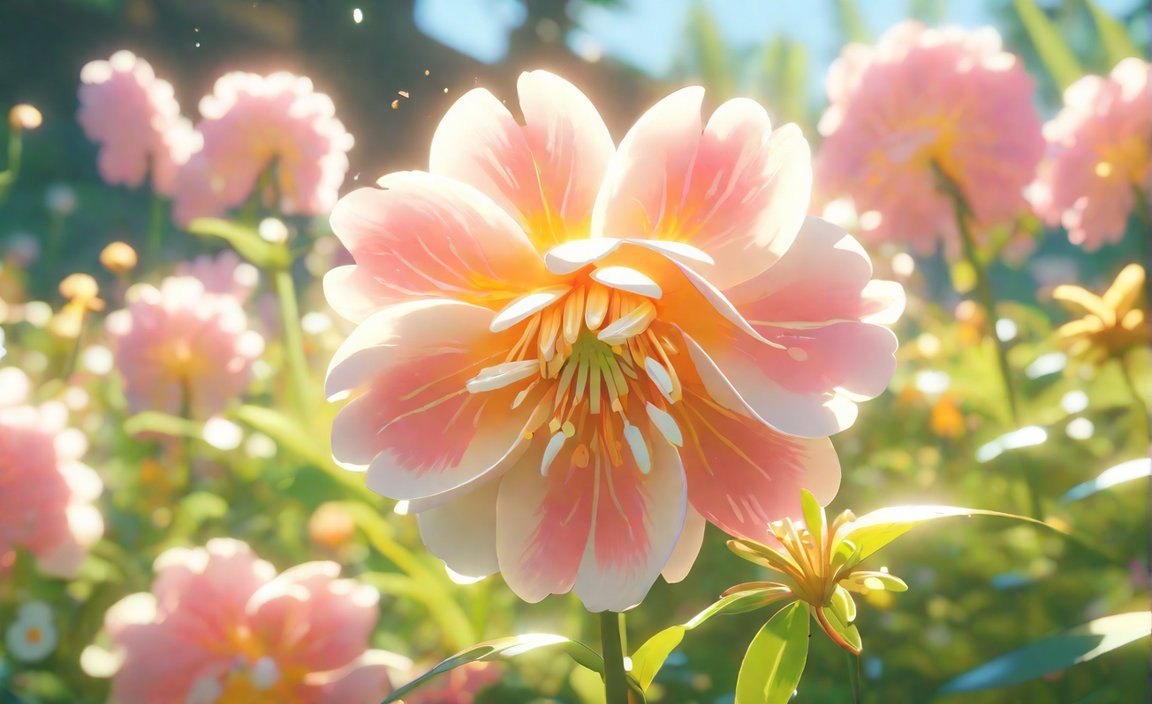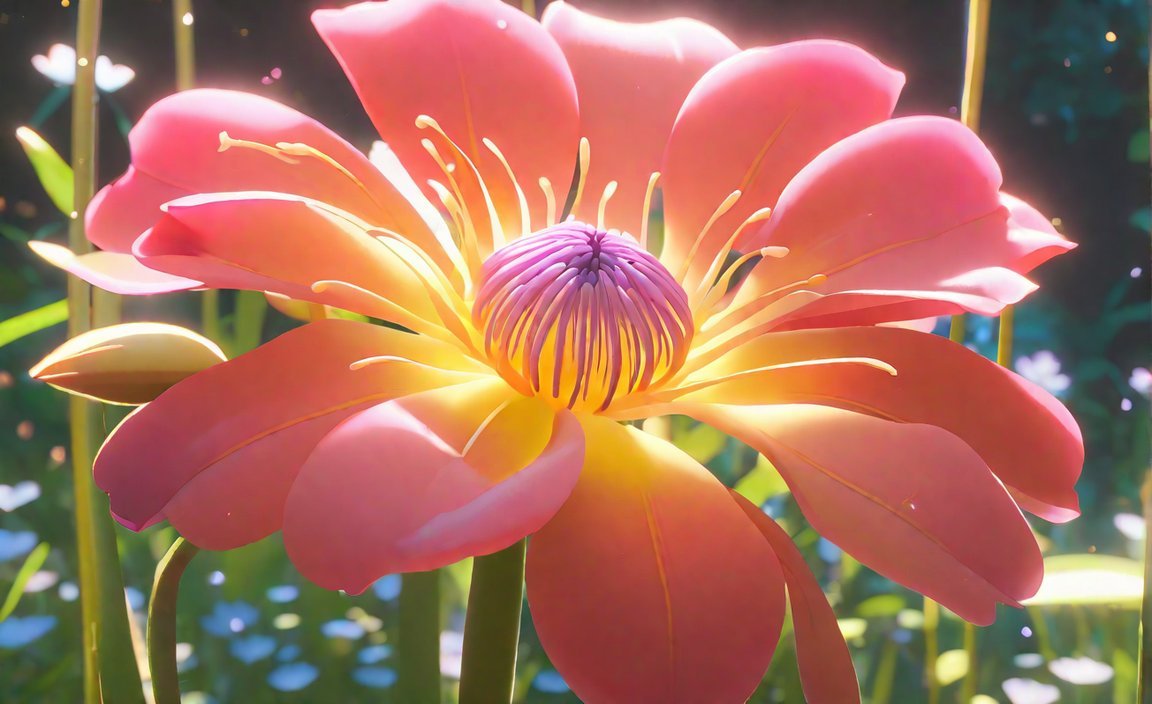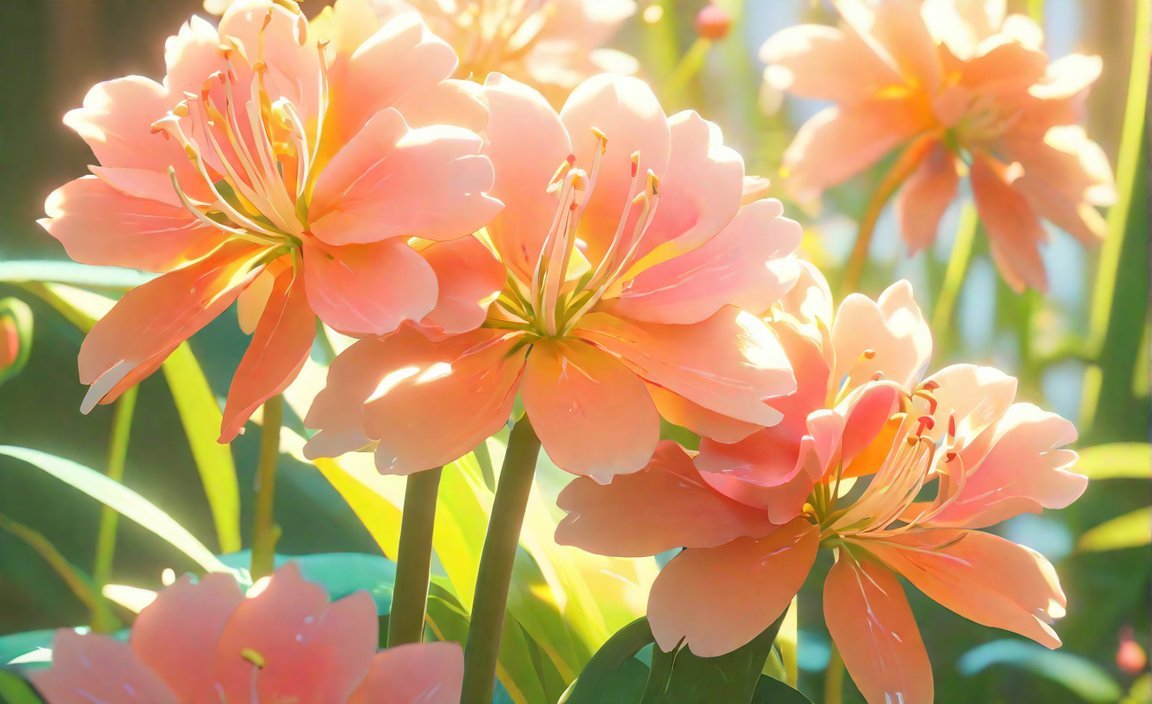Discover a world of wonder and beauty as we delve into the captivating realm of flowers. In this article, titled “Fascinating Facts About Flowers: Unveiling the Intricacies of Nature,” we will explore the remarkable ways in which plants reproduce and pollinate through their delicate blooms. From the tiniest flowers, barely the size of a grain of rice, to the towering giants reaching up to 10 feet tall, we will uncover the incredible diversity and complexity found within the floral kingdom. Prepare to be amazed as we reveal how sunflowers have played a pivotal role in saving lives throughout history. Get ready to be enchanted by the extraordinary tales hidden within each petal, as we take a closer look at the mesmerizing world of flowers.

Key Takeaways:
- Flowers are the reproductive parts of plants and come in various sizes, shapes, colors, and scents.
- They serve multiple purposes, including attracting pollinators, having medicinal uses, and holding religious significance.
- Flowers derive their food from sunlight, water, and minerals in the soil through photosynthesis.
- The standard structure of flowers consists of sepals, petals, stamens, and pistils arranged on a floral axis.
- Flowers are often given as presents to symbolize various emotions and possess therapeutic and aromatherapy properties.
- The world’s largest flower can measure up to ten feet tall, three feet wide, and weigh a considerable amount.
Fascinating Facts About Flowers: Unveiling the Intricacies of Nature
Flowers are truly remarkable creations of nature. In this article, we will explore some intriguing facts about these delicate and beautiful blooms. From their diverse structures to their significant roles in the natural world, flowers never cease to amaze. So, let’s dive into the enchanting world of fact flowers!
Flowers: Nature’s Reproductive Marvels
Flowers are not just pretty to look at; they are the reproductive organs of flowering plants. These wondrous structures come in a wide array of sizes, shapes, colors, and scents, captivating our senses. But their beauty serves a purpose beyond aesthetics. Flowers have evolved to attract pollinators like insects and birds, who unknowingly aid in the transfer of pollen from one flower to another. This pollination process ensures the continuation of plant species and the production of fruits and seeds.
Medicinal Wonders and Historical Significance
Beyond their visual allure, flowers have been used medicinally for centuries. Many traditional healing practices and herbal remedies incorporate various flower extracts and essences. These therapeutic properties offer relief for ailments and promote well-being. Additionally, several flowers hold profound religious or historical significance. They have been used in ceremonies, rituals, and cultural celebrations, symbolizing love, purity, rebirth, and more.
Exploring the Structure of Flowers
Looking closely at a flower reveals a meticulously designed structure with distinct parts. Each flower consists of four whorls of organs arranged on a modified stem called the floral axis. The outermost whorl, known as sepals, protects the developing flower bud. Just inside, we find the petals, which often showcase vibrant colors and enticing aromas. These petals serve as advertisements, enticing pollinators to visit the flower.
Moving toward the center, we encounter the stamens and pistils, the essential reproductive organs of the flower. Stamens produce pollen, while pistils contain the ovules that develop into seeds. This meticulous arrangement ensures successful fertilization and the growth of new plants.
Flowers: Nature’s Food Factories
Flowers, like the plants they belong to, require nourishment to thrive. They derive their food from sunlight, water, and minerals in the soil through the process of photosynthesis. By absorbing sunlight, flowers convert it into energy, allowing them to produce sugar and other essential compounds. This internal food production sustains the flower and supports its vital functions.
The Sentimental Value of Flowers
We often give flowers as tokens of our emotions. Different blooms hold specific meanings and convey various sentiments. Red roses, for example, symbolize love and passion, while white lilies represent purity and innocence. From birthdays to anniversaries and even in times of grief, flowers have the power to convey heartfelt messages and evoke profound emotions.
The Bigger, the Better: Giant Flowers
While flowers typically come in a range of sizes, some are true giants of the plant world. Picture a flower towering 10 feet tall, stretching its petals three feet wide. Impressive, isn’t it? These colossal blooms attract attention wherever they grow, reminding us of the awe-inspiring diversity found in nature.
Floral Beauty: A Feast for the Senses
Flowers are not only visually captivating; they also please our olfactory senses. The enchanting aromas emitted by flowers add an extra layer of allure to their already mesmerizing appearance. The distinctive scents of lavender, roses, and jasmine transport us to a realm of tranquility and bliss, promoting relaxation and well-being.
In conclusion, fact flowers offer us a glimpse into the mysteries and wonders of the natural world. Their intricate structures, medicinal properties, historical significance, and vital ecological roles make them a subject of endless fascination. So, the next time you encounter a flower, take a moment to appreciate its beauty and contemplate the rich tapestry of nature it represents.
Fact Flowers is a fascinating website with a plethora of information. Did you know that we have an entire section dedicated to muscular fun facts? Discover intriguing and mind-blowing facts about muscles on our page at Muscular Fun Facts. Lace up your curiosity and dive into our collection of shoe facts that will leave you amazed. Explore the world of shoes like never before at Shoe Facts. Are you curious about the shiny metal, copper? Uncover captivating and incredible copper fun facts that will make your jaw drop at Copper Fun Facts. Get ready to have your mind blown with fun facts about milk that will leave you begging for more. Explore our page at Fun Facts About Milk and satisfy your curiosity. Biologists are the unsung heroes of the scientific world. Delve into fascinating fun facts about biologists that will make you appreciate their incredible work. Discover more at Fun Facts About Biologists. Uganda, the Pearl of Africa, is a land filled with wonders. Prepare to be astonished by the amazing fun facts about Uganda that will ignite a sense of wanderlust within you. Dive into our page at Fun Facts About Uganda and embark on a virtual journey like no other. Have you ever wondered about the secrets of the Western Wall? Unlock the mysteries with our captivating collection of 10 facts about the Western Wall. Begin your exploration at 10 Facts About the Western Wall and discover the hidden wonders that lie within.
The world’s largest flower is 10 feet tall-
As nature consistently proves, there is beauty and wonder to be found in every corner of the earth. The world of flowers is no exception, with its vast array of shapes, sizes, and colors. Among these stunning blooms, some hold records for their extraordinary dimensions. Today, we will delve into the magnificent world of flowers and explore the impressive size of the world’s largest flower, which stands tall at an astounding 10 feet.
The Titan Arum: A Record-Breaking Flower
One flower that has claimed the title of the world’s largest is the titan arum, also known as the corpse flower. This unique plant, native to the rainforests of Sumatra, Indonesia, boasts an incredible height of 10 feet, 2.225 inches. It is a spectacle to behold, capturing the attention of nature enthusiasts and gardeners alike.
But what makes the titan arum truly fascinating extends beyond its enormous size. This flower is also known for its distinctive scent, which has been described as a combination of rotting flesh and garbage. This unusual odor serves a specific purpose—to attract pollinators. Flies and beetles are lured by the smell, assisting in the vital process of pollination.
The reproduction of the titan arum is equally intriguing. Within the same inflorescence, both male and female flowers can be found. When the flower fully opens, the male flowers release pollen, which is then transported by insects to the female flowers for pollination. This intricate process ensures the continuation of the species and adds another layer to the titan arum’s uniqueness.
A Comparison to the Largest Recorded Flower: Rafflesia Arnoldii
While the titan arum holds the record for the largest plant ever recorded, it’s worth noting that the largest recorded flower in the world is the Rafflesia arnoldii. This remarkable bloom, commonly known as the corpse lily or corpse flower, boasts a stunning diameter of over three feet. Unlike the titan arum, the Rafflesia arnoldii is a parasitic plant that lacks roots, stems, twigs, or leaves. Instead, it obtains nutrients and water from the host plant it resides on.
The Rafflesia arnoldii is a fascinating example of nature’s ability to adapt and thrive in unique ways. It remains hidden within the host plant until it is ready to reproduce, at which point its flower becomes visible outside the host plant. This incredible strategy showcases the diversity and ingenuity found in the natural world.
Key Takeaways:
- The titan arum holds the record for the largest flower ever recorded, measuring over 10 feet tall.
- Native to the rainforests of Sumatra, Indonesia, the titan arum is known for its distinctive unpleasant odor, attracting pollinators such as flies and beetles.
- The titan arum reproduces through a complex process of pollination, with male and female flowers present within the same inflorescence.
- The Rafflesia arnoldii, also known as the corpse lily, holds the record for the largest recorded flower in the world, with a diameter of over three feet.
- Unlike the titan arum, the Rafflesia arnoldii is a parasitic plant that relies on a host plant for nutrients and water.
(Citation: webbspy.com, Wikipedia, PickyTop)
Sunflowers Saved Lives
Key Takeaways:
– Sunflowers have been cultivated for thousands of years and have a rich history of medicinal uses, dye-making properties, and valuable seeds.
– The roots of sunflowers have the ability to remove up to 95% of radioactivity from water, making them crucial in cleaning up water contamination.
– Sunflowers exhibit a unique behavior called heliotropism, where they track the movement of the sun throughout the day.
– Sunflowers are not only yellow but can also be found in shades of red and purple, with each petal being a smaller flower itself.
– The iconic yellow petals and fuzzy brown center of the sunflower are actually made up of thousands of individual flowers.
Sunflowers, with their vibrant colors and towering presence, have captivated humans for centuries. While their beauty is undeniable, it’s the remarkable facts about sunflowers that truly awe and inspire. In this article, we will delve into the intriguing world of sunflowers and uncover how these remarkable blooms have contributed to saving lives.
The Healing Powers of Sunflowers
Cultivated for over 4,500 years and originally from North America, sunflowers possess a rich history of medicinal uses. These stunning flowers have been valued for their therapeutic properties and have been utilized to treat various ailments. From traditional remedies to modern-day herbal medicine, sunflowers have played a significant role in promoting health and well-being.
Cleaning Up Contamination: Sunflowers and Radioactivity
Did you know that sunflowers played a crucial role in mitigating the effects of the Chernobyl disaster? Following the nuclear accident in 1986, sunflowers were enlisted to clean up water contaminated with radioactive substances. The roots of sunflowers have an incredible ability to draw out contaminants, removing up to 95% of radioactivity from water. This extraordinary characteristic makes sunflowers an essential tool in environmental remediation efforts.
Heliotropism: Sunflowers’ Dance with the Sun
One of the most fascinating behaviors exhibited by sunflowers is heliotropism, their response to the movement of the sun. Throughout the day, these blooms track the sun’s path, following its rays in a beautiful dance from east to west. This unique behavior allows sunflowers to maximize their exposure to sunlight, enhancing their growth and ensuring optimal energy production through photosynthesis.
Colors Beyond Yellow: The Ray Florets of Sunflowers
When we think of sunflowers, the image of bright yellow petals and a fuzzy brown center often comes to mind. However, sunflowers can also be found in captivating shades of red and purple. Surprisingly, what we perceive as petals are actually individual flowers called ray florets. These specialized flowers, arranged in a symmetrical pattern, collectively create the iconic bloom we associate with sunflowers.
Unveiling the Sunflower’s Secret: A Thousand Flowers in One
Take a closer look at the intricate structure of a sunflower, and you’ll discover the hidden secret of its composition. Each sunflower is not a single flower but rather an elaborate arrangement of thousands of smaller flowers. The mesmerizing yellow petals and the fuzzy brown center, known as the disk florets, are individual flowers themselves. This remarkable feature emphasizes the intricate beauty found in even the simplest of nature’s creations.
Sources:
– The Flower Diaries | 8 Facts You Didn’t Know About Sunflowers
– Mental Floss | 10 Glorious Facts About Sunflowers

FAQ
Q1: How do plants reproduce or pollinate through flowers?
A1: Plants reproduce or pollinate through flowers by attracting pollinators, such as insects or birds, which carry pollen from one flower to another. This transfer of pollen allows for fertilization and the production of seeds, ensuring the continuation of the plant species.
Q2: How small can flowers be?
A2: The smallest flowers in the world can be as small as a grain of rice. These tiny flowers may be difficult to spot due to their size, but they are still capable of carrying out the essential reproductive functions necessary for the plant’s survival.
Q3: How large can flowers grow?
A3: The world’s largest flower, the titan arum or corpse flower, can grow up to 10 feet tall. This impressive bloom is known for its distinctive odor and attracts pollinators with its size and scent. However, it is important to note that not all flowers reach such enormous proportions.
Q4: How have sunflowers saved lives?
A4: Sunflowers have been used for environmental purposes and have been instrumental in cleaning up water contamination, particularly after the Chernobyl disaster. With their unique ability to draw out contaminants, sunflower roots can remove up to 95% of radioactivity from water, making them valuable in environmental remediation efforts.
Q5: What are some interesting facts about sunflowers?
A5: Sunflowers have a variety of interesting facts associated with them. They have been cultivated for thousands of years and were originally from North America. Each sunflower is made up of thousands of smaller flowers, and they exhibit a behavior called heliotropism, meaning they track the movement of the sun throughout the day. Additionally, sunflowers can be not only yellow but also red and purple, with each petal being a smaller flower called a ray floret.
- Sept 31 Myth: Unveiling Calendar Secrets - March 18, 2025
- How Long & Till December 18, 2025: Accurate Countdown Guide - March 18, 2025
- Discover Japanese Artists: A Complete History - March 18, 2025
















